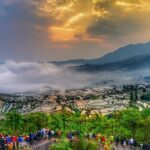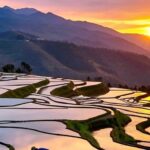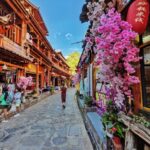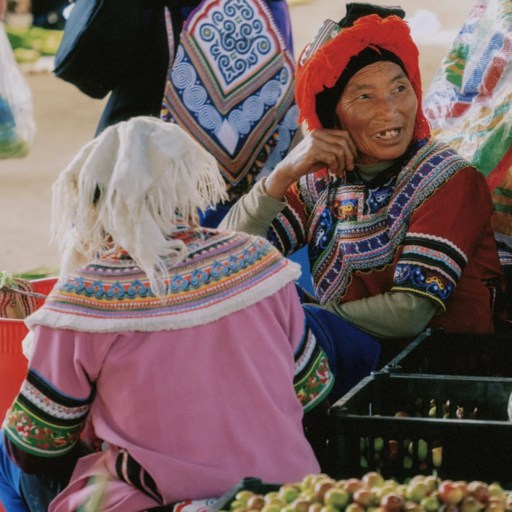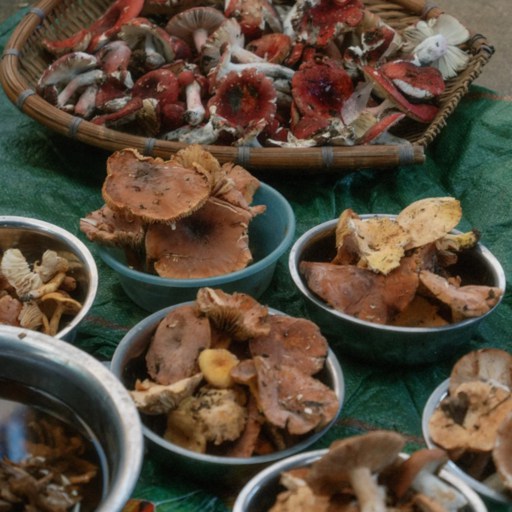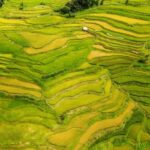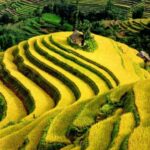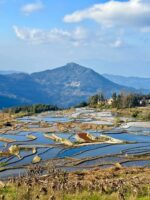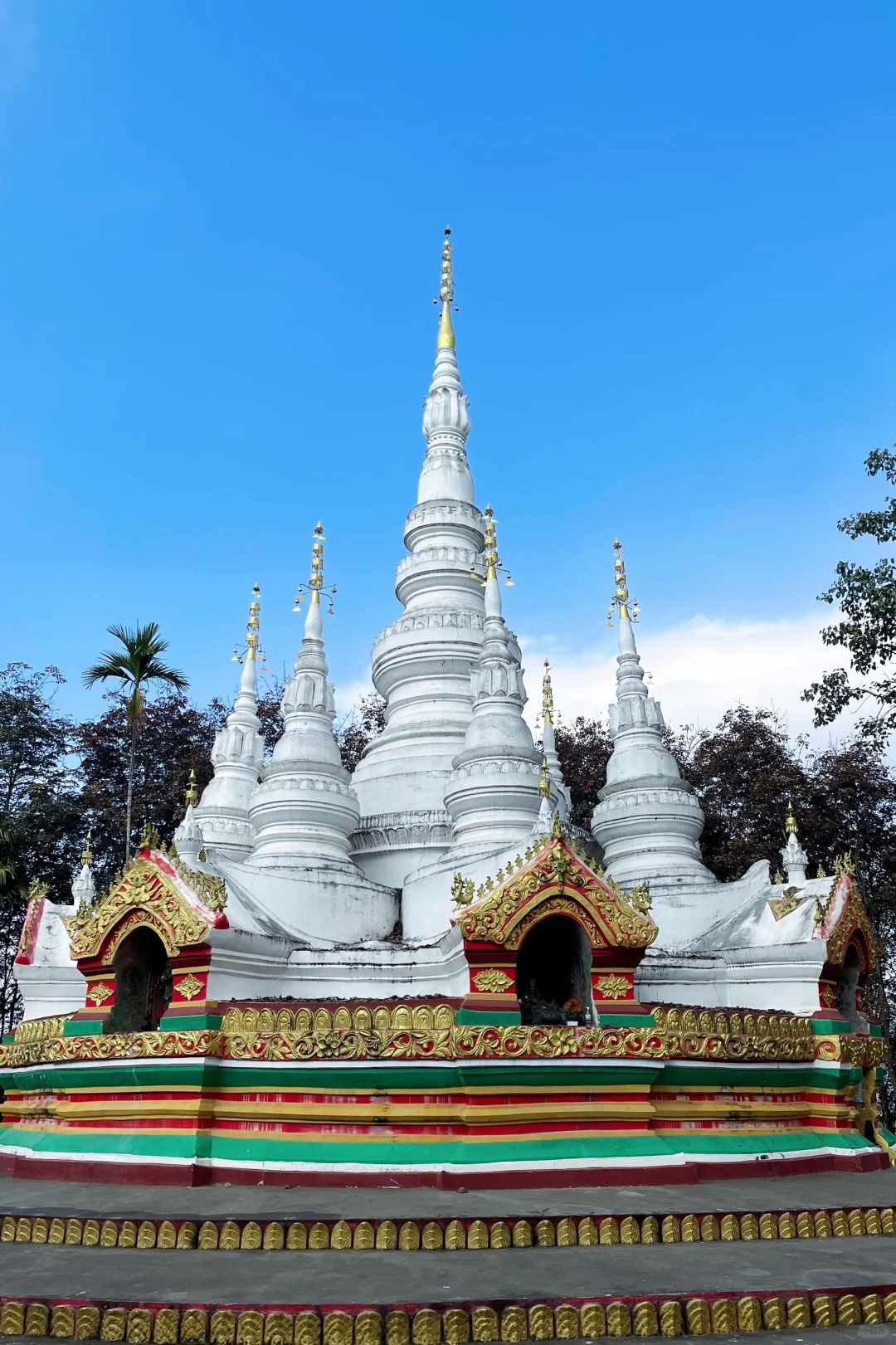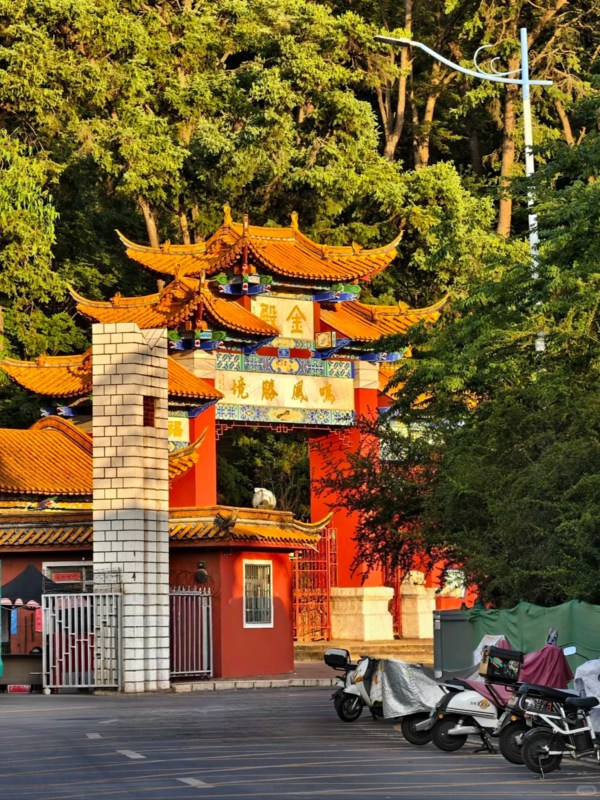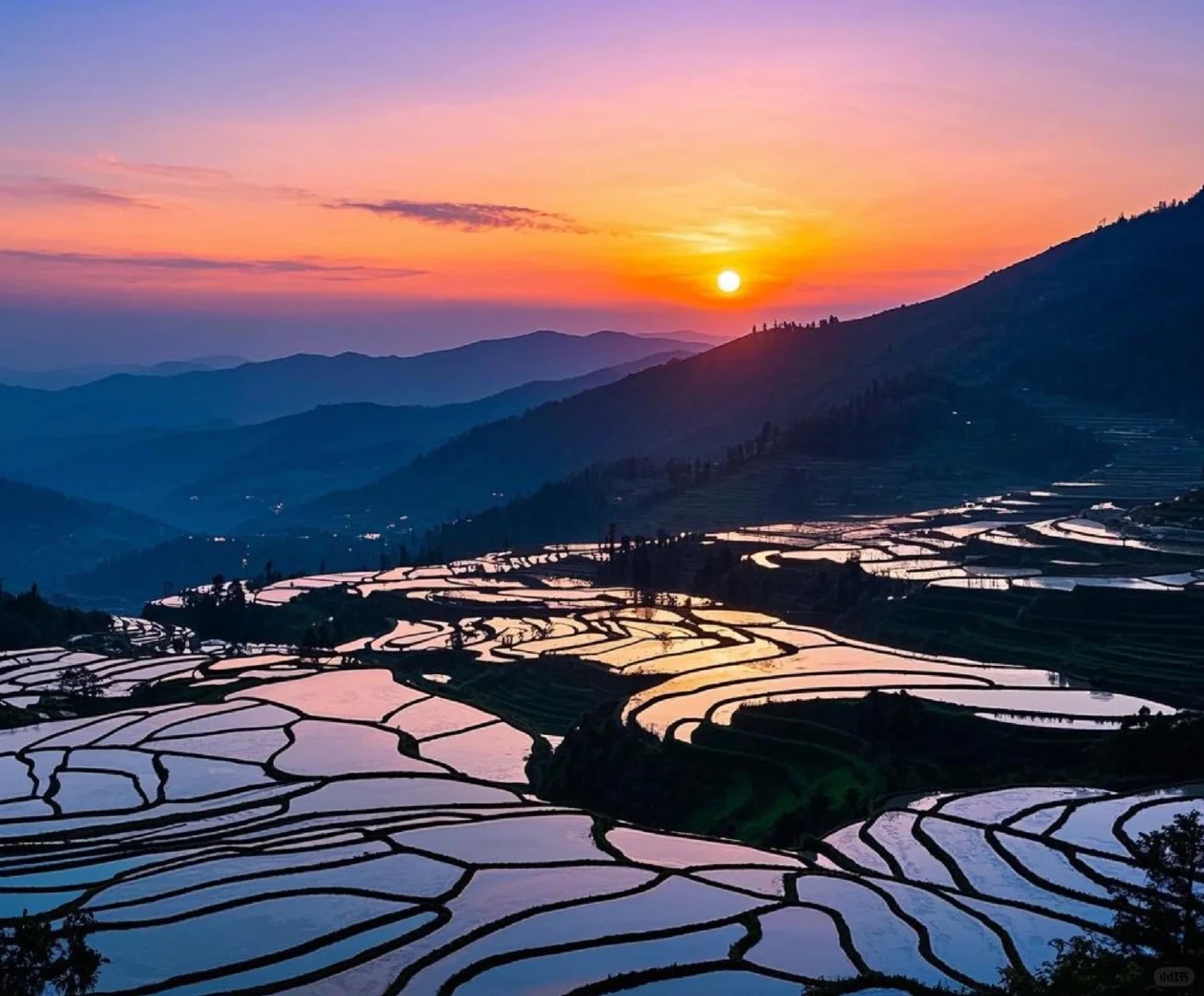
Yuanyang Rice Terraces
The Yuanyang Rice Terraces are not any other scenic site. They are such a place that you just find yourself in a mid-sentence due to the speed at which the light changes and your ability to respond is slow. These terraces, which the people of Hania had constructed through centuries, are twisting and curving down the mountains like pieces of a puzzle and each of their fields captures another color of the sky. You will find people carrying baskets of farmers, smoke in kitchen fires and children running after ducks in between the paddies.
When you are going down out of Kunming, you may count on a road time of about half a dozen, that is, 6 hours,--long, all right, but what curves. The best parts? Spending the sunrise at Duoyishu, sunset at Laohuzui and knowing that the scene never repeats itself. Bring patience, good shoes, a camera which can keep pace.
Quick Facts About Yuanyang Rice Terraces
| Location | Honghe Prefecture, Southern Yunnan (around 320 km from Kunming) — also called honghe hani rice terraces |
| Best Time to Visit | November – March (water-filled mirror season) |
| Entrance Fee | ¥70–100, valid for main scenic areas like Duoyishu, Bada, Laohuzui |
| Getting There | 6 hrs by bus or private car from Kunming; frequent departures from Kunming South Bus Station |
| Accommodation Range | From ¥150–500/night, most guesthouses in Duoyishu & Xinjie accept foreign guests |
| Opening Hours | 06:00 – 19:00 (times vary by season and light) |
Why Yuanyang Rice Terraces Are Unlike Anywhere Else
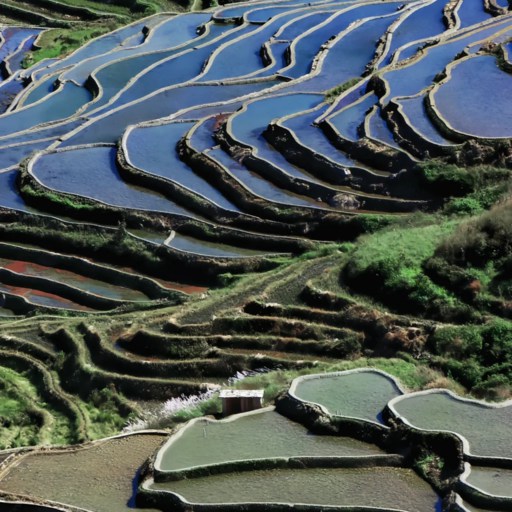
Scene of Yuanyang Rice Terraces
A Landscape Carved by 1,300 Years of Patience
Go out in the fog early in the morning, and you will hear the clanging of cow bells even before you visualize the fields. The yuanyang rice terraces roll down the slopes as though made of liquid glass and every step is a demonstration of the patience of the Hani people. This enormous system that is chiseled in a total of 1,300 years, according to UNESCO, covers a total of over 16,000 hectares. It is not only farm land, but an ecosystem. The Hani constructed the canals which direct the water flowing off the forested mountain tops into the paddies and the soil remains alive and the hills green despite the dry winters.
One can smell it here, stink of mud and wood fire smoke. The terraces are not symmetrical and not planned, they twist round the cliffs, and down them, vanish behind trees, and reappear where the sun next strikes. You soon know that they were not meant as tourist-friendly but to survive. Once the fog has cleared the fields are silver, then gold, then deep blue, depending upon the movement of the clouds. It feels ancient but alive.
Hani People and Their Living Traditions
The Hani, those who have made this land, are still claimed to remain between the terraces and the woods. Their villages are embraced on the ridges and the mushroom-shaped houses comprise of earth and straw that offers warmth even during the cold nights. You may observe the women of embroidered jackets with bamboo flasks being carried by them during the Water Worship Festival, in order to bless the streams watering their crops. Once I was sitting in a small courtyard in Duoyishu Village where an old man poured me smoke and honey wine. When I coughed, he laughed, and said that wine was not strong, just to wake up.
Life here moves slow. You will have the old folks busy working on baskets by the fire, kids running after chickens close to the mud walls, and men repairing bamboo fences after it rains. It is all enclosed and it seems that the outside world ends at the start of the forest. That is the silent strength of Yuanyang Yunnan it remains real.
Harmony Between Humans and Nature
There is no way one can look at the Hani Rice Terraces without experiencing the harmony that they have created which is water, forest, village and sky feeding each other. Nothing goes to waste. The water is safeguarded by the trees, the fields are sustenanced by the water and the people are nourished by the land. It is a circle closed down working centuries later. When you are on a ridge at sunset, you cannot help but believe that there is something that contemporary cities can learn about this location, which serves as a reminder that despite being built on the same land, there is a possibility to find beauty and life.
Best Viewpoints and Villages in Yuanyang Rice Terraces
Duoyishu — The Iconic Sunrise Point
Where to begin, ask anybody, and he will tell you: Duoyishu, before dawn. The highway ascends in fog so dense you can scarcely make out your feet, but the initial tints of the orange cut through it like lightning. Residents embrace themselves with quilts, tourists place their tripods, and all people remain silent after several minutes. The yuanyang rice terraces below become reflections- blue, pink, gold, occasionally even of all these. You can hear, as well, water running and shutters clicking, applause.
In case of photos, they must be here by 5.30 a.m. because the sun is behind the ridge. The best season? During winter when the paddies are full and the reflections are clearest. Most buy a quick snack in the Duoyishu viewpoint cafe (black coffee and buns, approximately ¥20) when most of the people have cleared out. Be patient, you can be long in leaving, half the beauty lies in the mist passing between layers, and you can never see enough of that.
Bada — Where Clouds Roll Over the Fields
Assuming that Duoyishu is light, Bada is movement. In the afternoon the clouds come in again and over the paddies go as though they were slick as smoke, the Ailao Mountains. The perspective is broadened, the terraces are piling one above another out into the horizon. It is the most excellent perspective of yuanyang rice terraces to watch the sunset, the light became silver then amber and blood red within some few minutes.
In the TripAdvisor, photographers usually suggest coming between 5:00 p.m. and 6:00 p.m. when the valley is full of mist. It has a wooden platform on the top and in case you are lucky, local children will take you through on where to step down to get low shots. Bring a jacket; the wind is snatching quick here.
Laohuzui (Tiger Mouth) — Dramatic Terraces and Steep Valleys
Laohuzui feels wilder. The terraces plunge down into a ravine, claw-like in their curves--so that they are called the Tiger Mouth. There are also more intense colors; during late afternoon the flooded paddies appear to be of copper red and the dry ones are pale green. Other photographers refer to it as the heartbeat of Yuanyang.
The Tripadvisor reviews observe that it is not so crowded but more difficult to access as it would require around 30 minutes by car once one comes to Xinjie. It has a little ticket booth (¥30) and the path leading to the lower observation point. Wait until it stops pouring; the road becomes greasy quickly. But it is the combination of danger and beauty that makes Laohuzui unforgettable.
Xianrendong Village — A Hidden Corner Few Tourists Reach
The only thing that most travelers do not visit is xianrendong village and that is why it feels special. Here the Hani families continue to dry their chili and corn upon bamboo racks, and to have roosters wandering to and fro over the terraces. Basic yet clean homestays can be as cheap as ¥180250 a night, and most hosts may receive foreigners. Nights are silent, only crickets and the dog barking here and there in the valley.
In case you do not wish to see what the yuanyang rice terraces would be without selfie sticks and crowd noises, do not go away. The stars are shining, the air smells of smoke and earth, and you feel as though the earth were breathing more slowly than ever,--as though it wanted to make you keep pace with it.
Stay, Eat, and Live Like a Local in Yuanyang
- Local Market
- Local Mushroom
Where to Stay — Hotels and Hani Homestays
It is not just a question of comfort to find a bed in yuanyang yunnan, it is a question of waking up to the drifting clouds over the terraces. Majority of the travelers remain around Duoyishu or Xinjie which is aromatized with pine and damp soil. The most popular one is Timeless Terrace Guesthouse (TripAdvisor 4.6★) and the rooms have floor-to-ceiling windows that look into the yuanyang rice terraces, even the owner is a Hani woman, named Lamu, who can speak enough English to get you taxi or sunrise trips. The cost is roughly about 300-400 a night and foreigners are allowed.
In Pugao Laozhai, Jacky in his Guesthouse is hidden in the middle of a village, Hani. The interior is plain, cozy, and made of wood, yet as if the perspective through the balcony is unlimited. Look on to roosters in the morning, and mist creeping in at the cracks of the windows, pretty, though not in pursuit of luxury. The Yuanyang Aerial View Hotel in New Town has standard facilities, good Wi-Fi, and western breakfast (approximately 500-600 per night) to those who would find more comfort. It is convenient to the families that require simple transportation.
What to Eat — Hani Cuisine and Local Markets
In this place, food is like smoke, earth and time. The Hani people prepare food at a slowness which is predominantly done using wood fires. Duoyi Shu is packed each morning every morning in the market with the scent of fried soybeans being cooked in massive iron woks. Sample Hani tofu feasts, when all the items are based on the same ingredient: soup, fried tofu, cold tofu salad. Locals also plunge it in a blend of chili and pickled ginger that burns and soothes simultaneously.
If you want to dive deeper into Yunnan’s rich food scene — from wild mushrooms to rice noodles and spicy street snacks — check out our detailed Yunnan Cuisine Guide here.
When you come across bottles of cloudy white rice wine on a stall, then that is homemade mi jiu, which is slightly sweet though not as strong as it appears. One of the grandmothers said I must have hers, and poured it out of an old bottle of Sprite; it heated quicker than coffee could ever do. The markets begin about 7:00 am, and the best greens and pork are cleared by nine. Prices remain low - breakfast less than 20yen, lunch about 40yen when you share among yourselves.
It is not a fine dining experience in yuanyang rice terraces villages when eating. It is about the rhythm - early mornings, common tables, and tastes which remain a long time after you are out of the mountains.
When Is the Best Time to Visit Yuanyang Rice Terraces?
The Mirror Season (Nov – Mar)
Photographers asked for the best time to visit the yuanyang rice terraces will tell you, "visit when the water comes." For that period, from November to March, every terrace becomes a mirror — hundreds of small ponds reflecting the sky. TripAdvisor reviews of "sunrise at Duoyishu" read almost exactly alike: fingers freezing, mist concealing everything, then, suddenly, golden rays of light splitting the mist. The reflection transforms every second — pink, silver, then blue again. natives go about with their buffaloes among the pools, perfectly doubled reflections of their own shapes. It is the sort of scene that makes you forget to check your camera settings.
If you’re curious how Yunnan’s landscapes shift once spring arrives, you can find a seasonal travel guide and flower-viewing tips right here — read more in our Travel to Yunnan in Spring article.
All the hotels are soon filled up during the Chinese New Year time, and early reservations are advisable. The temperature goes to below 5°C., but the mornings are full of photographers bundled up in blankets and tripods. Wear gloves, for metal is "colder than ice." This is the season when the yuanyang rice terraces look unreal, like glass piled on top of mountains.
Green Shoots and Clouds (Apr – Jun)
The paddies awaken in April as the water recedes to reveal the small shoots of rice and the terraces become neon green through the shifting mist. Sunlight dances on the fresh blades of jade. This is also the start of the rains here, with the storms rolling in quickly and disappearing with equal speed. The clouds do not settle here but glide down the valleys and envelop your bus, swimming into the rivers.
The vagaries of muddy paths gives the traveler something to complain about, but it is part of the trade. If the morning is fine, the terraces glow brighter than all screens show. For the employer of the drone, the colours are perfect this time of the year, the vivid fields of the paddies, the gray of the skies behind them. For the lover of the less frequented parts of the world, this is the pause between the tourist peaks of the middle of the summer. Nothing staged, just life in the yuanyang rice terraces.
Golden Harvest (Sep – Oct)
In autumn the entire environment smells of rice husks and fried grass. The paddy field is dried and beautifully golden and the beautiful haze of warmth shines over it and it expands far into the horizon. You will see farmers bending down with their sickles and children chasing fowls up the ridges. The harvest festivals start in October and the markets give forth all sorts of beautiful chilies, mushrooms and cakes of sticky rice wrapped in the beautiful leaves of the banana tree. It is not such an introspective time as the winter but the light is softer in shade and the sunsets are late.
The TripAdvisor people call it the “most human” season of the year. They forget all about the photography of it but they do live in it. The average traveller can help the local farmers harvest rice if he requests permission gracefully. It is a dirty job, noisy, and strange amounts of fun. This is the yuanyang rice terraces in full action.
Visiting Yuanyang Rice Terraces in Winter
Winter in Yuanyang is quieter than silence itself. The villages are deserted after dark, and all that can be heard is a dog barking and the wind brushing over the roofs. Great clouds of smoke arise from the mushroom-shaped houses; the air is pungent with burning pine. The fields, though bare, still shine in the rising sun; and there is something almost religious in the emptiness — there are no noises, no hurry, but just time for meditation. It is also just the season when the roads are frozen at night, so take care in your journeys.
The bus timetables are subject to change without notice, and the worst of all is that many of the guest-houses are closed for short periods. Nevertheless, if you are in search of solitude, the Yuanyang rice terraces in winter yield it in great profusion. The landscape is the property of the local people again, and for once it is you who is becoming melted with the scenery.
FAQ About Yuanyang Rice Terraces
Q: How do I travel from Kunming to yuanyang rice terraces?
From Kunming South Bus Station, take a long-distance bus to Xinjie Town — it’s about 6 hours and costs roughly ¥120–150. Buses usually leave around 10:00 a.m. and 1:00 p.m. You can also hire a private driver through Trip.com or Ctrip for ¥700–900 per car. Roads are winding but scenic, passing through Jianshui and Honghe towns along the way.
Q: How long should I stay in yuanyang rice terraces?
Two nights work best — one for sunrise at Duoyishu, another for sunset at Bada or Laohuzui. If you want slower travel and time to explore villages, plan 3 days. Many travelers regret rushing; the terraces change color with every hour. The rhythm of yuanyang rice terraces isn’t meant for speed, so give it a bit of time to sink in.
Q: Do I need a guide or can I travel independently?
You can easily travel on your own. Signs in pinyin guide you through major viewpoints, and local guesthouses often arrange rides for ¥30–50. A guide helps if you’re interested in Hani festivals or small villages. But for the main yuanyang rice terraces, maps, Google offline mode, and a few local tips are enough. It’s safe and friendly even for solo travelers.
Q: Are yuanyang rice terraces worth visiting in winter?
Definitely. The yuanyang rice terraces winter season (Nov–Mar) is when they’re flooded and most photogenic. Mornings can hit 5°C, but the reflections are unreal. It’s quieter, cheaper, and easier to find a room. Just bring layers and waterproof shoes — paths can freeze overnight. Travelers on TripAdvisor call it the “mirror season” for a reason.
Q: What’s the difference between yuanyang and Longji rice terraces?
Longji (in Guangxi) is more developed — easier access, more hotels, and bigger crowds. The yuanyang rice terraces, on the other hand, feel raw and wild. They’re carved by the Hani people, steeper, and more dramatic in light. You trade convenience for authenticity. If you love photography or quiet landscapes, Yuanyang easily wins the comparison.
Q: What’s the entrance fee for yuanyang rice terraces?
The all-area pass costs around ¥70–100, covering Duoyishu, Bada, and Laohuzui viewpoints. You can buy tickets at the visitor center near Xinjie or on Trip.com. Keep the stub — it’s valid for two days. Locals say early morning entry sometimes skips checks, but better stay honest. Kids under 1.2m enter free.
Q: Is it safe to drive or ride a motorbike there?
It’s generally safe but not easy. Roads are narrow and curvy, especially in fog. If you ride, keep speeds under 30 km/h and watch for livestock. Foreigners can’t rent bikes without a Chinese license, but locals offer short rides for small tips. Better hire a driver unless you’re experienced. The views are worth slowing down for anyway.
Q: What’s the nearest airport to yuanyang rice terraces?
The closest is Mile Airport (under construction), but for now, Kunming Changshui International Airport is the main gateway. From there, take the metro to Kunming South Station, then the bus to Yuanyang. Total travel time is around 7 hours including transfers. It’s a long journey, yes, but when you reach the first ridge and see sunlight on the paddies, you’ll forget the ride completely.
